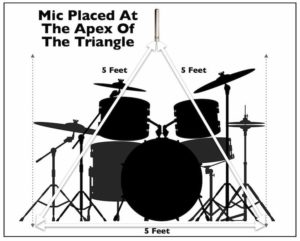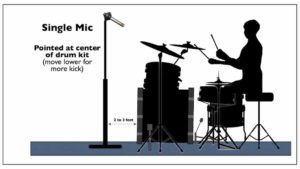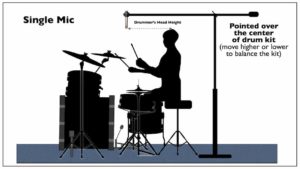- in Book Excerpt , Engineering , Recording by Bobby Owsinski
6 Techniques For Miking A Drum Kit With A Single Mic

© 2017 Bobby Owsinski (source: iStock Photo)
Just because you have a lot of mics and tracks at your disposal, that doesn’t necessarily mean that you’ll get a great drum sound. Sometimes, the simplest methods can provide a realism that you just can’t get from close-miking every drum. Here are 6 techniques culled from my Recording Engineer’s Handbook that show how you can get some surprisingly good results from just a single mic.
Technique #1: Visualize an equilateral triangle with the base of the triangle being the overall width of the kit; then position a mic (start with a cardioid pattern but don’t be afraid to try other patterns) at the apex of the triangle, directly above the center of the kit. In other words, the height of the mic is the same as the width of the kit (see the figure on the left).
Technique #2: Position a mic 3 feet in front of the kit about 3 feet high, looking between the toms and the cymbals toward the snare. If you need more kick, lower the mic. If you need less, move it higher and away from the kick.
Technique #3: Place a mic about 3 feet in front of the drums with the mic high enough to point down at the snare (the center of the kit) at about a 45-degree angle. If you need more kick, lower the mic. If you need less, raise it (see the figure below).

© 2017 Bobby Owsinski (source: iStock Photo)
Technique #4: Place a mic 5 feet high and 8 feet or so directly in front of the kit. This method may provide a more balanced kit, but it will have much more room ambiance.
Technique #5: Place a mic over the drums but about even with the top of drummer’s head. Make sure that the mic is angled at the whole kit in such a way as to get coverage of the toms without too much cymbals (see Figure below).

© 2017 Bobby Owsinski (source: iStock Photo)
Technique #6: Place a mic over the drummer’s right shoulder, angled down into the center of the kit.
- Variation: Use the same positioning as any of the above techniques, but use a stereo mic instead.
These single mic techniques won’t give you a wide spacious sound like miking in stereo can, but at least one of them will work well if you’re looking for that “vintage” focused sound.
You can read more from The Recording Engineer’s Handbook and my other books on the excerpt section of bobbyowsinski.com.

